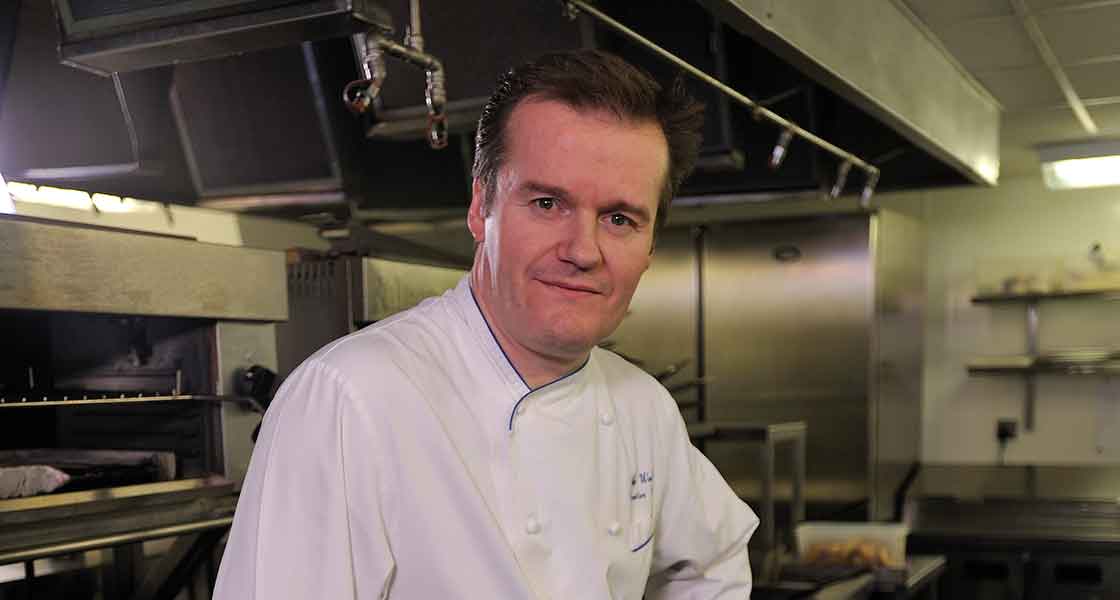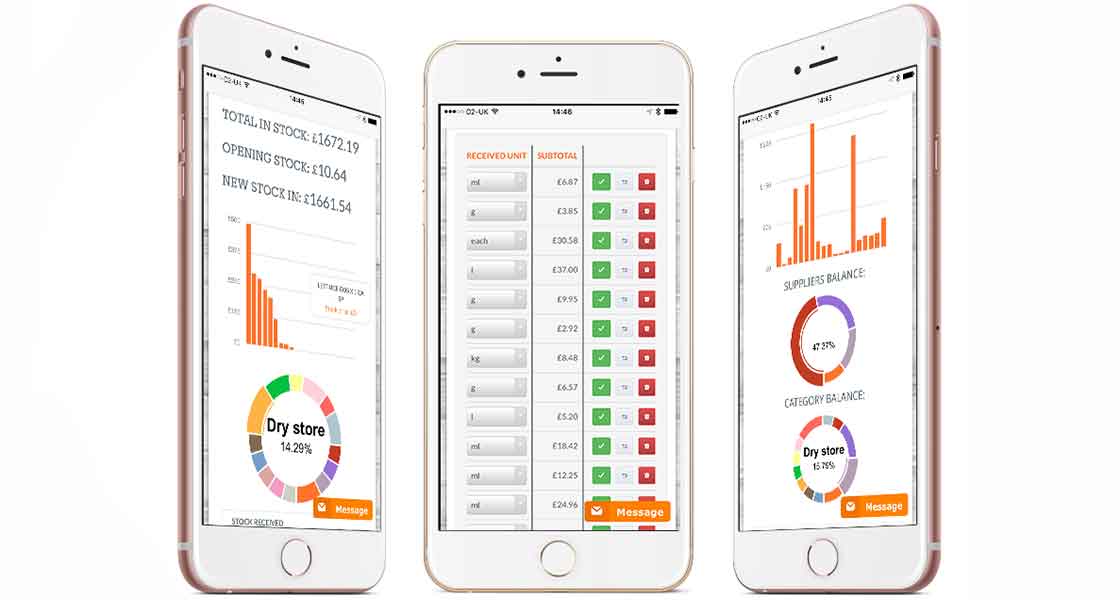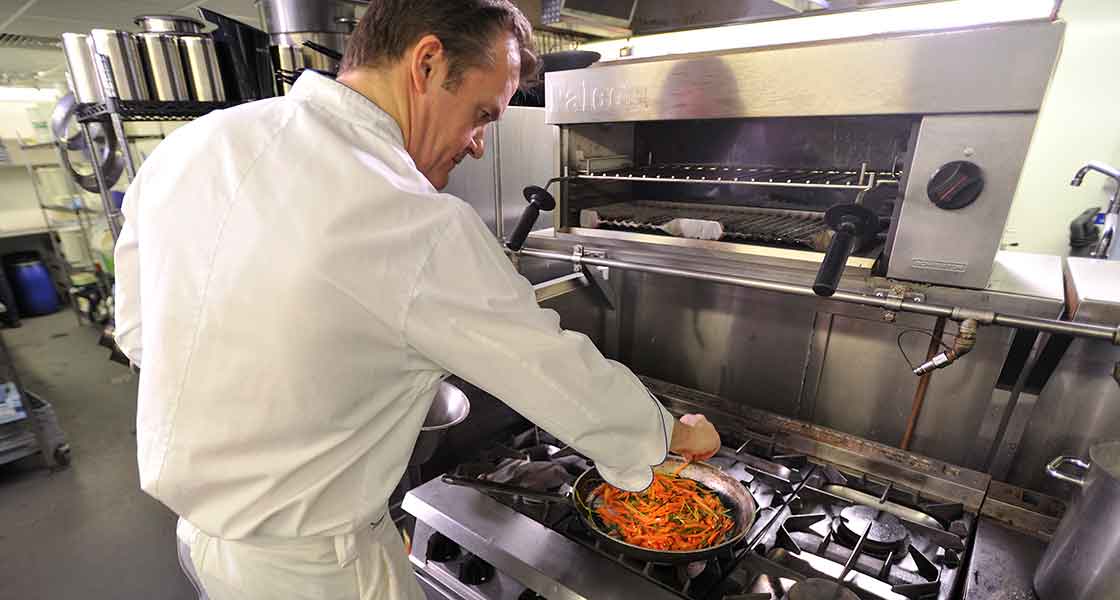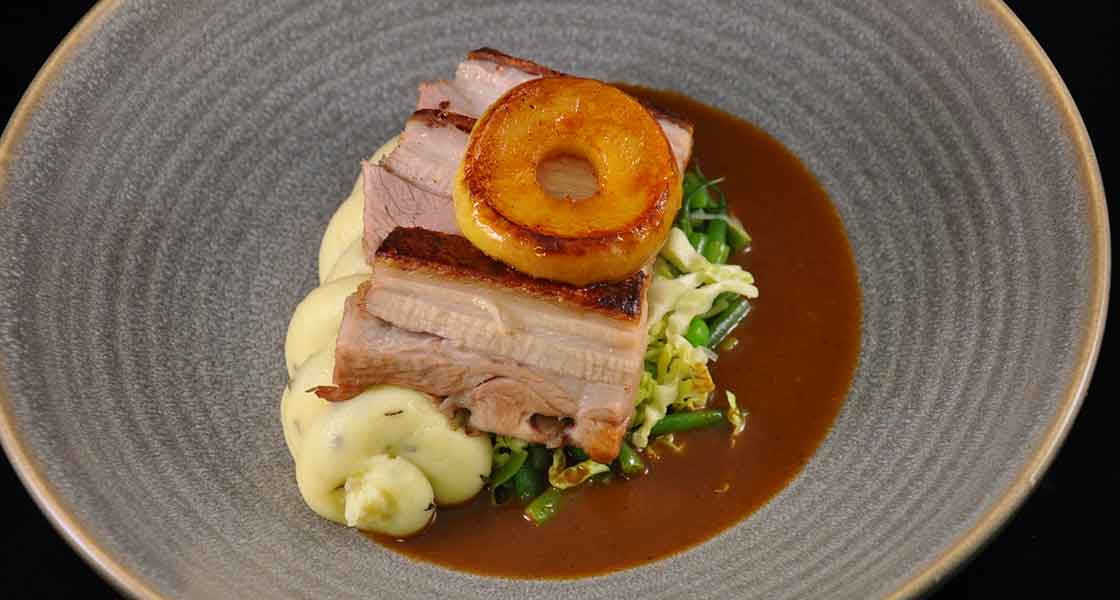Management Tool Enhances the Business Side of Restaurants
CULINARY POINT OF VIEW
During Chef John Wood’s 35-year career working in renowned kitchens like The Burj Al Arab in Dubai and The Cliveden Hotel, he realized that chefs were not being given the financial and business training they needed to run a successful hospitality business. So, he spent eight years researching and developing a unique food and beverage management software called Kitchen CUT that combines his culinary experience with technology to give chefs a way to easily store recipes, create menus, calculate wasting and food costs, create nutritional analysis, and more.

Q: You worked as a chef in well-renowned restaurants for over 25 years. What made you decide to leave the kitchen to start Kitchen CUT?
John Wood: I’ve actually been working in restaurants since I was about 15 years old, so it’s been about 36–37 years now. And I’ve always loved what I did. When you become a chef, it’s a passion—not a job. I was very fortunate to get the opportunities and to work in some fantastic hotels and restaurants in Persia, Iraq, and Dubai. I was able to work and be in the right places at the right times—both as a chef and owner (I had my own restaurant), food and beverage director, and as a consultant.
A lot of chefs nowadays are really burdened with the challenge of running operations. The days of just going in and cooking some great food and going home again are gone. Now, there are loads of administrative tasks, whether that be hiring-related, cost-related, allergens, or nutrition tracking.
I’ve worked with a lot of back-of-house systems, and have found that they are sort of clunky, not very intuitive, and I really had to struggle to get myself motivated to use them, let alone trying to get my team motivated to use them. I thought that there’s got to be a better way of doing this. So, I did about three years of research and development and spoke to a lot of people I knew all over the world in different fields. The biggest feedback we got back from all that research was to keep it simple. The Kitchen CUT system has been built with the chefs and managers in mind, and is easy to use and intuitive.
Q: It seems like there is more technology in the kitchen than ever before. Has there been an influx of competitors since you launched Kitchen CUT in 2012? What does your system offer that the competitors don’t?
Wood: I go to a lot of tech shows and they are dominated with front-of-house technology, such as payment systems, loyalty CRMs [customer relationship management], and point-of-purchase tills. There are companies entering the foodservice tech field, but not many of them do what we do. Our system is a food and beverage management system—it looks at food, beverage, and consumables. One way Kitchen CUT differs from the others is that I used my 35 years of experience in the industry and insights from the chefs I have worked with over the years to develop it. The system is about the simplicity and the intuitive nature of what we [as chefs] do. I’ve worked with hundreds of chefs in my career and they want—and need—a simpler way to manage the business side of the restaurant.
The intricacies of the Kitchen CUT system remain behind the scenes and we aim to keep it as simple as possible for the chefs so it is easier for them to embrace the technology. We are unusual as a tech company in that my goal is to get all chefs back into the kitchen. Get them to do those tasks they must do and make it a fun, easy experience, and then get them back doing what they love—cooking.

Q: A lot of attention is placed on the culinary aspects of being a chef, as opposed to the financial and business aspects. How do you think culinary education could be improved to help chefs succeed?
Wood: I think it can definitely be improved. This is one of my passions—passing my knowledge, skills, and expertise onto other people. It all starts with college and when they enter their first cooking jobs—whether they go through a formal apprenticeship, college first, or straight into the industry. We need to ensure that these young people who that want to be chefs are being nurtured, trained, educated.
I think there’s a huge drop-out rate of chefs in the industry globally, and it’s our responsibility—people that work in the industry—to change that. A lot of chefs I know have been promoted through the ranks because of their culinary skills and end up in senior positions and suddenly they’re in charge of $2–$3 million worth of purchasing and they need to get their margins in line. No one has ever taught them those skills. They’ve built an entire career as a chef and nobody has ever sat them down and walked them through the financial implications of how to run a business.
That is why this industry needs to change, and people are talking more about it, which is great. But, even if they learn about operations in culinary school, it could be 10–15 years before they become head chef and by that point they have forgotten the operational skills they learned in school. In my mind, we’re producing a lot of cooks but not enough chefs.
Q: Implementation of the FDA’s menu labeling rule has been delayed until next year to give restaurants more time to comply. How does Kitchen CUT help restaurants do that?
Wood: When it comes to menu labeling, nutrition, and calories, we initially looked at the FSA [Food Standards Agency] database that has all the nutritional information predominantly for the United Kingdom and Europe. As I was examining it, I realized you can’t choose whether a chicken breast is poached, steamed, boiled, or fried—which changes the calorie value—so the accuracy of it was wrong. Then we looked at the USDA [U.S. Dept. of Agriculture] one and we combined the two databases, which gave us 12,000 ingredients. We can then map those ingredients in the Kitchen CUT system for recipes to give the chef the total nutritional data.
These new requirements put a lot of pressure on businesses. They don’t know how they are going to meet the requirements. Do they need to get a nutritionist? Or send all the recipes away to get them analyzed by a nutritionist for $15, $20, or $30 a recipe. What we want to do with Kitchen CUT is give them an easier way to do all of that.

Q: Food waste is a huge global challenge that has been getting a lot of attention from governments, environmental organizations, and media. I know that Kitchen CUT was awarded a EU grant a couple of years ago to help cut waste in kitchens. Can you tell me a little more about how your company is doing that?
Wood: In my mind, food waste is not just about figuring out what food waste costs and comparing it to last month. What we want to do is examine and develop a whole education process for managing food waste. It’s about giving chefs a system that allows them to track that—when was the food wasted and how much did it cost—but also analyzes why they are wasting the food. The system can give insights into patterns that are occurring. For example, perhaps every Wednesday when the relief chef works, the amount of food wasted increases. Seeing those trends and patterns enables a chef to put a long-term strategy plan into place to deal with wastage. If you put structure, systems, training, and support in place, you can reduce your wastage.
In my mind, there are six different types of wastage. There’s ordering waste. You need proper systems in place and not just the chef picking up the phone and just ordering whatever they want.
Stock management is another area where waste happens. Kitchen CUT has a stock management system that manages the stock and gives theoretical stock values of what a chef has in the business every single hour of the day. This lets them see where the stock is at and how they should be using it.
Then it’s about product cross-utilization—how the menus are compiled, what is falling out of the production of each one of the dishes, and how the byproducts are going to be used somewhere else in the menu.
Next is preparation waste, which is about yielding product correctly so waste is reduced during the preparation process because there are specs and standards, such as how to cut and chop items properly. This is addressed in the Kitchen CUT system as well, and videos can be dropped into the system to help educate people on how to prep properly.
And then there’s portion control with the recipes so one guest isn’t being served a larger portion than the next guest. This provides continuity in the product, which also makes the guests happy.
And, finally, it comes down to plate waste. Some may argue that the consumer paid for it so who cares if they eat it or not, but if plate waste is tracked the data could reveal that it’s possible to downsize a portion.
The Kitchen CUT system gives restaurants the transparency to deal with all of these issues. You can’t avoid wastage. You can reduce it, but it is inevitable, and people don’t take that into account when they sell their dishes. And because they don’t take it into account, they don’t achieve their margins because they haven’t built it into their costings.

Q: What’s next for Kitchen CUT and for your career?
Wood: We’re always looking at growth—different markets such as hotels and healthcare, and different regions of the world through the addition of new languages and nutrition requirements. Functionality is always huge for us. Not only do we speak to our users and ask them what they want to see, but we also ask ourselves “Where should technology in kitchens be at in five years?” Let’s come up with some crazy ideas, because one out of 10 of those crazy ideas may be brilliant. We are having conversations right now about the system having voice recognition so the chefs could record the recipes by talking to it. We’re also looking at algorithms so that we can start to pull data that tells chefs different things about how their customers are eating.
From a personal point of view, I’m passionate about this industry and love imparting my knowledge of what I have learned from my 35 years in the industry.
This interview has been edited and condensed for clarity.

Cider-braised pork belly, buttered cabbage and thyme mash
This is a classic marriage of flavors—pork, apple, and thyme
Preparation time: 15 minutes
Cooking time: 2 hours 50 minutes
Total time: 2 hours 30 minutes
Serves: 4–6
Ingredients:
- 1 tbsp olive oil
- 1.4 kg piece pork belly, rind removed, cut into 3cm x 4cm cubes
- 3 Cox apples, cored, and cut into 6 rings
- 3 cloves garlic, peeled, and finely chopped
- 8 sage leaves, roughly chopped
- 1 tbsp thyme leaves, chopped
- 500 mL bottle of dry cider
- 500 mL chicken stock
- Preheat the oven to 150°C. Heat the oil in a large, ovenproof casserole and fry the pork in batches for 5 min until golden, transferring to a plate with a slotted spoon as you go. Drain off all but 2 tbsp of the fat, add the apple rings, and cook until golden brown and put to one side.
- Add the garlic to the pan, fry for a minute, then add the sage and thyme. Pour over the cider, bring to the boil, then simmer for 5 min. Pour in the chicken stock, then return the pork to the pan, and bring to a simmer. Cover with a lid and transfer to the oven for 2½ hr.
- Carefully remove the cooked pork with a slotted spoon and transfer to a warm serving dish. Skim any excess fat from the braising liquid then bring to the boil and reduce by half. Pour the sauce over the pork and serve with thyme mashed potatoes and buttered cabbage, beans, and peas. (see below)
Mashed thyme potatoes
Ingredients:
- 700 g Yukon Gold or Desiree of a good mashing potato
- 60 mL heavy cream
- 30 g butter
- 25 mL milk
- Salt and pepper
- Place the peeled and cut potatoes into a medium saucepan. Add cold water to the pan until the potatoes are covered by at least an inch. Add a half teaspoon of salt to the water.
- Turn the heat on to high and bring the water to a boil. Reduce the heat to low to maintain a simmer and cover. Skim any scum that comes to surface off. Cook for 15–20 min or until you can easily poke through them with a fork.
- While the potatoes are cooking, melt the butter and warm the cream.
- When the potatoes are done, drain the water and place the steaming hot potatoes back into the same pan. Pour the heated cream and melted butter over the potatoes.
- Mash the potatoes with a potato masher. Then use a strong wooden spoon to beat further.
- Add milk and beat until the mashed potatoes are smooth. Don’t over beat the potatoes or they will end up gluey.
- Add salt and pepper to taste.
Buttered cabbage
Ingredients:
- 1 Savoy/Green cabbage
- 250 g green fine beans
- 175 g of fresh (or frozen) peas
- 50 g butter
- Salt and pepper
- Cut cabbage into quarters and remove core and base.
- Shred cabbage leaves.
- Remove base of the beans and cut in half to 2–3 cm long.
- Bring a pan of salted water to the boil.
- Add all veggies at the same time and boil until tender.
- Drain well and add back to pan. Place pan back on heat, add butter, and season.


